
The Hanseatic League was a medieval commercial and defensive confederation of merchant guilds and market towns in Central and Northern Europe. Growing from a few North German towns in the late 12th century, the League between the 13th and 15th centuries ultimately encompassed nearly 200 settlements across seven modern-day countries, ranging from Estonia in the north and east to the Netherlands in the west and Kraków, Poland, in the south.

Mecklenburg-Vorpommern, also known by its anglicized name Mecklenburg–Western Pomerania, is a state in the north-east of Germany. Of the country's sixteen states, Mecklenburg-Vorpommern ranks 14th in population; it covers an area of 23,213 km2 (8,963 sq mi), making it the sixth largest German state in area; and it is 16th in population density. Schwerin is the state capital and Rostock is the largest city. Other major cities include Neubrandenburg, Stralsund, Greifswald, Wismar, and Güstrow. It was named after the 2 regions of Mecklenburg and Vorpommern.
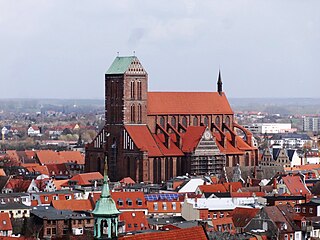
Wismar, officially the Hanseatic City of Wismar is, with around 43,000 inhabitants, the sixth-largest city of the northeastern German state of Mecklenburg-Vorpommern, and the fourth-largest city of Mecklenburg after Rostock, Schwerin and Neubrandenburg. The city was the third-largest port city in former East Germany after Rostock and Stralsund.

Stralsund, officially the Hanseatic City of Stralsund, is the fifth-largest city in the northeastern German federal state of Mecklenburg-Western Pomerania after Rostock, Schwerin, Neubrandenburg and Greifswald, and the second-largest city in the Pomeranian part of the state. It is located at the southern coast of the Strelasund, a sound of the Baltic Sea separating the island of Rügen from the Pomeranian mainland.
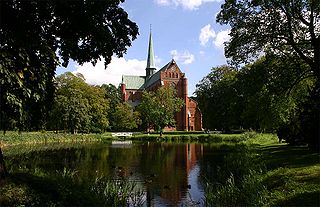
Bad Doberan is a town in the district of Rostock, Mecklenburg-Vorpommern, Germany. It was the capital of the former district of Bad Doberan. In 2012, its population was 11,427.

Heiligendamm is a German seaside resort founded in 1793.

Brick Gothic is a specific style of Gothic architecture common in Northeast and Central Europe especially in the regions in and around the Baltic Sea, which do not have resources of standing rock. The buildings are essentially built using bricks. Buildings classified as Brick Gothic are found in Belgium, Netherlands, Germany, Poland, Lithuania, Latvia, Estonia, Kaliningrad, Denmark, Sweden and Finland.

The Lübeck law was the family of codified municipal law developed at Lübeck, which became a free imperial city in 1226 and is located in present day Schleswig-Holstein. It was the second most prevalent form of municipal law in medieval and early modern Germany next to the Magdeburg Law.

The architecture of Germany has a long, rich and diverse history. Every major European style from Roman to Postmodern is represented, including renowned examples of Carolingian, Romanesque, Gothic, Renaissance, Baroque, Classical, Modern and International Style architecture.

The Krämerbrücke is a medieval arch bridge in the city of Erfurt, in Thuringia, central Germany, which is lined with half-timbered shops and houses on both sides of a cobblestone street. It is one of the few remaining bridges in the world that have inhabited buildings. It has been continuously inhabited for over 500 years, longer than any other bridge in Europe. The stone, pedestrian bridge, which dates from 1325, is one of the oldest secular structures in Erfurt. It spans the Breitstrom, a branch of Gera River, and connects two town squares – Benediktsplatz and Wenigemarkt.
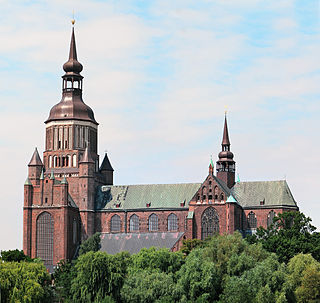
St. Mary's Church is a large Lutheran church located in Stralsund, northern Germany. Built some time before 1380, it is architecturally Gothic, an outstanding example of the Brick Gothic style prevalent in northern Germany and in the Baltic states. Between 1549 and 1647, it was the tallest building in the world at 151 metres (495 ft) tall, excepting the interval 1569–1573 between the completion and collapse of the tower of St. Pierres Cathedral in Beauvais. As part of the historic centre of Stralsund, the church was inscribed on the UNESCO World Heritage List in 2002.

The Cathedral Basilica of the Assumption is a Gothic cathedral located in Pelplin, Poland, one of the country's largest medieval churches. A former church of the Cistercian Pelplin Abbey, it is the seat of the Roman Catholic Diocese of Pelplin. It is listed as a Historic Monument of Poland.

St. Nicholas Church is the oldest of the three major parish churches of the Hanseatic city of Stralsund in Germany. It was dedicated in 1279 to St. Nicholas of Myra, the patron saint of sailors. Since 1524 it has been an Evangelical Lutheran church. It is one of the earliest examples of the introduction of the cathedral pattern of northern France into the Brick Gothic architecture of the Baltic region. As part of the historic centre of Stralsund, St. Nicholas Church was inscribed on the UNESCO World Heritage List in 2002.
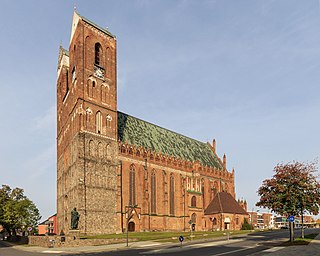
The Marienkirche in Prenzlau, Brandenburg, Germany, is the main Protestant parish church in the town, and is one of the most ornate churches of the Brick Gothic style in northern Germany. The church is a listed building.
Dankwart Guratzsch is a German journalist. He has made a name for himself above all as an architecture critic.
The Deutsches Musikinformationszentrum (MIZ) is the information and documentation institution of the Deutscher Musikrat. It has set itself the task of providing information about the structures, tasks and developments of the widely ramified musical life in Germany. To this end, it provides statistics, structural data and background information and offers guidance on current funding opportunities, specialist events and further education and training courses in the field of music.
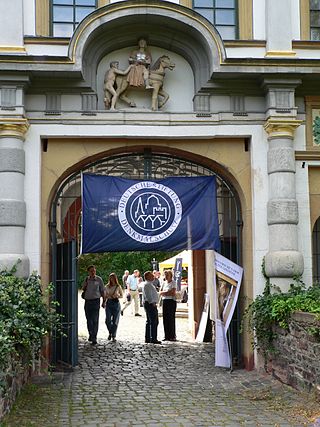
The Tag des offenen Denkmals is an annual event all over Germany. The day of action has been coordinated by the Deutsche Stiftung Denkmalschutz since 1993. Historic monuments are open to the public free of charge. It takes place on the second Sunday in September and attracts several million visitors each year. The largest cultural event in Germany is the contribution of the country to the European Heritage Days.
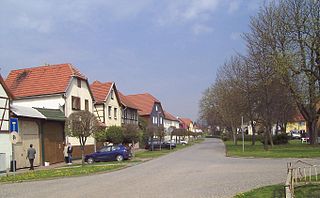
Bollstedt is a village and a quarter of the town of Mühlhausen in Thuringia, central Germany, situated on the left bank of the Unstrut.






















